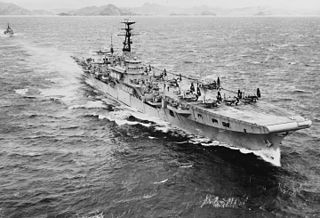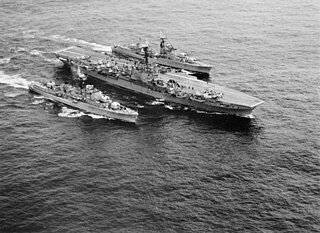
HMS Triumph was a Royal Navy Colossus-class light fleet aircraft carrier. She served in the Korean War and later, after reconstruction, as a support ship.

HMAS Barcoo (K375/F375/A245) was a River-class frigate of the Royal Australian Navy (RAN). One of twelve frigates constructed in Australia during World War II, Barcoo, was laid down by Cockatoo Docks & Engineering Company, Sydney in 1942, and commissioned in early 1944.

HMAS Burdekin (K376) was a River-class frigate that served the Royal Australian Navy (RAN) from 1944 to 1946. She was named for the Burdekin River in Queensland and was one of twelve River-class frigates built for the RAN during World War II.

HMAS Murchison (K442/F442) was a Modified River or Bay-class frigate of the Royal Australian Navy (RAN). The ship was laid down in 1943, but not commissioned until after the end of World War II. Murchison fought in the Korean War, was decommissioned in 1956, and sold for scrap in 1961.

HMS Morecambe Bay was a Bay-class anti-aircraft frigate of the British Royal Navy, named after Morecambe Bay on the north western coast of England. In commission from 1949 until 1956, she saw active service in the Korean War, and was sold to Portugal in 1961 to serve as NRP Dom Francisco de Almeida until 1970.

HMAS Sydney (R17/A214/P214/L134) was a Majestic-class light aircraft carrier operated by the Royal Australian Navy (RAN). She was built for the Royal Navy and was launched as HMS Terrible (93) in 1944, but was not completed before the end of World War II. The carrier was sold to Australia in 1947, completed, and commissioned into the RAN as Sydney in 1948.

HMAS Anzac (D59) was a Battle-class destroyer of the Royal Australian Navy (RAN). Named after the Australian and New Zealand Army Corps, the destroyer was commissioned in 1951. The ship served on two tours of duty during the Korean War, and attempts to distinguish herself from British ships led to the practice of red kangaroo symbols on Australian warships. During 1956, Anzac served during the Malayan Emergency. In 1960, a malfunction in the destroyer's gun direction equipment caused Anzac to fire directly on sister ship HMAS Tobruk during a gunnery exercise, with Tobruk left unrepairable. In 1961, the destroyer was reclassified as a training vessel. Anzac remained in service until 1974, and was sold for breaking a year later.

HMS Amethyst was a modified Black Swan-class sloop of the Royal Navy. She was laid down by Alexander Stephen and Sons of Linthouse, Govan, Scotland on 25 March 1942, launched on 7 May 1943 and commissioned on 2 November 1943, with the pennant number U16. After the Second World War she was modified and redesignated as a frigate, and renumbered F116.

The Amethyst Incident, also known as the Yangtze Incident, was a historic event which involved the Royal Navy ships HMS Amethyst, HMS Consort, HMS London, and HMS Black Swan on the Yangtze River for three months during the Chinese Civil War in the summer of 1949.

HMAS Vendetta was one of three Daring-class destroyers built for and operated by the Royal Australian Navy (RAN). The destroyer was built by Williamstown Naval Dockyard and entered service in 1958. During her early career, Vendetta was deployed to the Far East Strategic Reserve on multiple occasions. In 1965 and 1966, the destroyer undertook deterrence patrols during the Indonesia-Malaysia Confrontation. Along with several runs escorting the troop transport HMAS Sydney to South Vietnam, from late 1969 to early 1970 Vendetta was assigned to combat operations and became the only Australian-built warship to serve in a shore bombardment role during the Vietnam War.

USS Albuquerque (PG-115/PF-7), a Tacoma-class patrol frigate in commission from 1943 to 1945 and from 1950 to 1953, was the first ship of the United States Navy to be named for Albuquerque, New Mexico. She also served in the Soviet Navy as EK-14 and in the Japan Maritime Self-Defense Force as JDS Tochi (PF-16/PF-296) and as YAC-15.

The history of the Royal Australian Navy traces the development of the Royal Australian Navy (RAN) from the colonisation of Australia by the British in 1788. Until 1859, vessels of the Royal Navy made frequent trips to the new colonies. In 1859, the Australia Squadron was formed as a separate squadron and remained in Australia until 1913. Until Federation, five of the six Australian colonies operated their own colonial naval force, which formed on 1 March 1901 the Australian Navy's (AN) Commonwealth Naval Force which received Royal patronage in July 1911 and was from that time referred to as Royal Australian Navy (RAN). On 4 October 1913 the new replacement fleet for the foundation fleet of 1901 steamed through Sydney Heads for the first time.

USS Isabel (SP-521), later PY-10, was a yacht in commission in the United States Navy as a destroyer from 1917 to 1920 and as a patrol yacht from 1921 to 1946.

HMS Cardigan Bay was a Bay-class anti-aircraft frigate of the British Royal Navy, named after Cardigan Bay, off the coast of Ceredigion, Wales.
HMS St Brides Bay was a Bay-class anti-aircraft frigate of the British Royal Navy, named for St Brides Bay in Pembrokeshire. In commission from 1945 to 1961, she served in the Mediterranean and Eastern Fleets, seeing active service in the Korean War.

HMS Whitesand Bay was a Bay-class anti-aircraft frigate of the British Royal Navy, named for Whitesand Bay in Cornwall. In commission from 1945 to 1954, she served in the Pacific, Mediterranean, West Indies and Far East Fleets, seeing active service in the Korean War.

HMNZS Rotoiti (F625) was a Loch-class frigate of the Royal New Zealand Navy (RNZN), which had formerly served in the British Royal Navy as HMS Loch Katrine at the end of World War II.

HMNZS Hawea (F422), formerly HMS Loch Eck (K422), was one of six Loch-class frigates that served in both the Royal Navy (RN) and the Royal New Zealand Navy (RNZN). The ship was laid down by Smiths Dock on 25 October 1943, launched on 25 April 1943 and commissioned into the Royal Navy as HMS Loch Eck on 7 November 1944.

HMS Crane was a modified Black Swan-class sloop of the Royal Navy. She was laid down by William Denny and Brothers, Dumbarton on 13 June 1941, launched on 9 November 1942 and commissioned on 10 May 1943, with the pennant number U23. She saw active service during the Second World War, initially performing convoy escort roles in the Atlantic before supporting the Normandy landings. In the final months of the war, Crane joined the British Pacific Fleet and saw service during the Battle of Okinawa. Post-war, Crane remained in south-east Asia and took part in hostilities during the Korean War. She was redeployed to the Middle East during the Suez Crisis before returning to Asia for service during the Malayan Emergency. Crane was withdrawn from service in the early 1960's and was scrapped in 1965.

JS Abukuma (DE-229) is the lead ship of the Abukuma-class destroyer escorts. She was commissioned on 12 December 1989.


















